699 Search Results for communication book
September 7, 2017
by Carole Zangari -
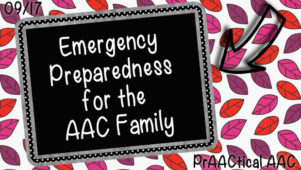
Many of us live in areas prone to storms or other game-changing weather events, but even those who don’t should prepare for emergency situations. Today, as we continue our preparations for Hurricane Irma, one of the strongest storms ever recorded in the open Atlantic, my friend, Amy Goldman, takes the reins. With her broad background in AAC and AT and her incredible advocacy work, we are in no better hands. If you’re inclined toward prayers or even if you’re not, we here in South Florida could use any positive energy you can send our way. Stay safe, friends, and remember to take care of those around you. ::::::::::::::::::::::::::::::::::::::::::::::::::::::: With the images of the devastation of Hurricane Harvey in front of us, and with Irma and possibly Jose in the forecast, it is actually a little late to be talking about emergency preparedness. However, it is good to reflect on some of... [Read More...]
May 18, 2017
by Carole Zangari -
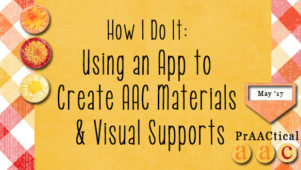
When we think of AAC apps, expressive communication and voice output generally come to mind. But there are other kinds of AAC apps, too, including those that are used to create printable materials. Today, we hear from a clinician who uses this kind of AAC app on a regular basis. Georgia Karavias is a speech language pathologist whose career has centered around working with school-aged children and adolescents who have physical disabilities and communication difficulties. Georgia is passionate about utilizing alternative access methods and inclusive technologies to enable independent communication using AAC systems. She currently works at Scope’s Communication and Inclusion Resource Centre (CIRC) as part of the communication access team in a community capacity building role. In this post, she talks about how she uses AAC and visual supports created with an app developed at her workplace. :::::::::::::::::::::::::::::::::::::::::::::::::::::::::::::::::::::::::::::::::::::::::::::::::::::::: I am a speech pathologist who has worked with children with complex... [Read More...]
March 8, 2017
by Carole Zangari -

The good news is plentiful. A growing number of classrooms incorporate some form of AAC. Teachers and therapists are increasingly aware of the value of augmentative forms of communication and are recognizing the potential for communication growth in all of their students. School teams are stepping up to provide access to activity-based communication boards, communication books, low tech SGDs, and AAC apps. They are creating opportunities for teaching and using these forms of AAC in specific classroom activities. In many cases, teachers and therapists are growing dissatisfied with the outcomes. Students are more engaged in the activities are improving their ability to participate appropriately. They aren’t always becoming competent communicators who can express themselves independently throughout the day. It’s frustrating to scramble to find and/or create materials and resources, make significant changes to activities, work hard to implement them, and still not get the expected outcome. It’s exhausting. It’s disappointing,... [Read More...]
February 16, 2017
by Carole Zangari -
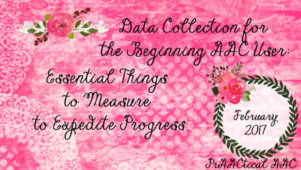
It’s exciting to see more and more teams on the road to implementing AAC in therapy and in the classroom. Often, though, our initial expectations for student progress don’t pan out. Consider these examples. Aleksander’s SGD has robust vocabulary that is customized specifically for him. He uses it consistently at snack and lunch time, but rarely uses it in other activities. Ariel uses her AAC app to ask for things, make comments, and answer questions but rarely goes beyond the single word level to express herself. Jayson had a PECS book for over a year and learned to request his favorite foods but not much else. His team switched Jayson over to a more robust AAC system, and while he learned to communicate for other reasons, he still doesn’t use his communication book very frequently unless he’s prompted to do so. Do these situations seem vaguely familiar? Helping AAC learners become... [Read More...]
January 15, 2017
by Carole Zangari -
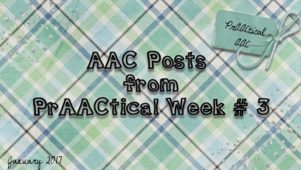
Here are a handful of posts you may have missed. Monday: PrAACtical Resources: Step-by-step Guide to Making a Tabbed Communication Book Wednesday: Video of the Week: A School-based Approach for Supporting the AT Needs of Young Children Thursday: Catching Up with National Joint Committee for the Communication Needs of Persons with Severe Disabilities
September 19, 2016
by Carole Zangari -
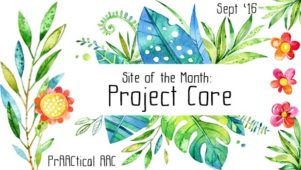
Our Site of the Month addresses a topic relevant to many of you who serve AAC learners. The Project Core website is the public face of a research project looking at the use of an AAC intervention program that uses a consistent set of core vocabulary that grows with the learner over time. The multi-tiered system for augmenting language used in this project begins with extensive aided language input and explicit instruction of selected core words during meaningful interactions throughout the school day. This forms a foundation on which more specialized and individualized intervention and vocabulary selection is built. The project is part of the Center for Literacy and Disability Studies at the University of North Carolina at Chapel Hill where the team has been developing a classroom-friendly intervention approach based on the System for Augmenting Language that was pioneered in the 1990s and continues to build an evidence base... [Read More...]
August 8, 2016
by Carole Zangari -
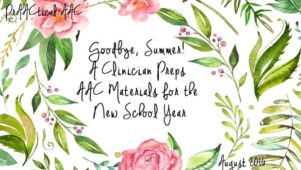
Here in the US, many SLPs who work in educational settings are getting ready to head back to school. In today’s post, we hear from Elizabeth Levy, an SLP at Wasatch County School District in Utah. Elizabeth, who earned her Bachelors and Master’s degrees from Towson University in Maryland, worked in early intervention for several years before joining the team at Midway Elementary two years ago. She has always had a passion for working with children who are nonverbal and require AAC, and is a member of ASHA’s Special Interest Group 12 (AAC). She also serves as part of her district’s AT team. In this post, Elizabeth shares a little bit about how she used the summer to gear up for an initiative to provide additional AAC support for students with significant learning challenges. ::::::::::::::::::::::::::::::::::::::::::::::::::::::::::::::::::::::::::::::::::::: This year, with a new team, I have a great opportunity to go big and... [Read More...]
July 20, 2016
by Carole Zangari -
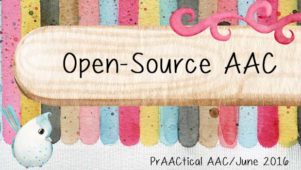
What’s better than a bunch of bright, dedicated professionals who love improving the state of AAC? How about a group that facilitates the collegial sharing of this kind of information?! In today’s post, Dr. Joe Reddington discusses his efforts to promote open-source AAC solutions. You can read about an earlier project, CommuniKate, here. ::::::::::::::::::::::::::::::::::::::::::::::::::::::::::::::::: AAC Wins the Inclusive Technology Prize A few months ago, the nonprofit I run was given £50,000 to make open licensed resources (both materials and software) a key part of the AAC world. Figure 1: Kate McCallum and Dr Joe Reddington, winners of the Inclusive Technology Prize There are lots of definitions of open-licencing that make it sound more than what it is. Open-licencing is nothing more or less than letting people share. One of the reasons we really like PrAACtical AAC is that they release their work under Creative Commons, letting people make use of... [Read More...]
March 28, 2016
by Carole Zangari -
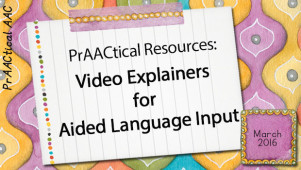
A growing number of clinicians, families, and educational teams are prioritizing the use of aided language input as a foundational strategy for AAC learners. When we first started writing about this strategy, it was rare to see adults using AAC to talk with AAC learners.Consistent implementation is still a challenge, but more and more of you are speaking AAC to teach AAC. And quite of few of you are doing your best to influence other stakeholders to support augmented communicators in this way. If you are doing inservices, teaching classes, or guiding teams toward better AAC intervention, the videos listed below may be useful to you in those efforts. Chris Bugaj developed this clear and engaging cartoon explaining the concept for people new to this strategy. Caroline Musselwhite recorded a full webinar with detailed information on aided language input. Communicare, a clinical practice with a strong focus on AAC,... [Read More...]
March 17, 2016
by Carole Zangari -
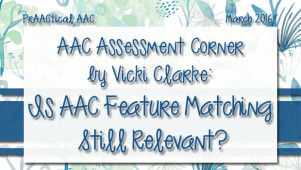
Today, we welcome back Vicki Clarke, a regular contributor to PrAACtical AAC, with another edition of AAC Assessment Corner. In this post, Vicki shares her thoughts on feature matching for AAC device selection. ::::::::::::::::::::::::::::::::::::::::::::::::::::::::::::::::::::::::::::::::::::::::::::::::::::::::::::::::::::: Feature matching has been the gold standard for AAC evaluation for the last 20 years. It is research based and clinically proven as the best technique for selecting an AAC solution for an individual. The tide of real-life practice, however, is turning and there has been increasing discussion at conferences, in social media and blogs questioning why we continue to use feature matching to place AAC systems in the hands of students. In a recent assistive technology on-line chat, a noted AT specialist remarked: “I wonder if at a district level it might not be better to have a go-to AAC system everyone tries first. If that doesn’t work then adjust.” Does this mean that we throw... [Read More...]









